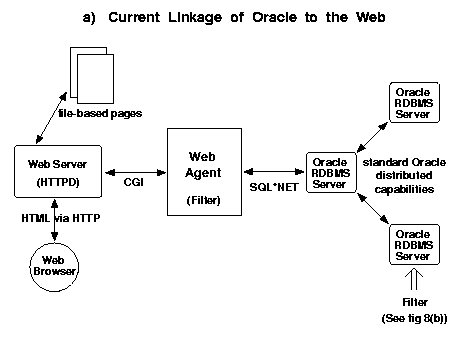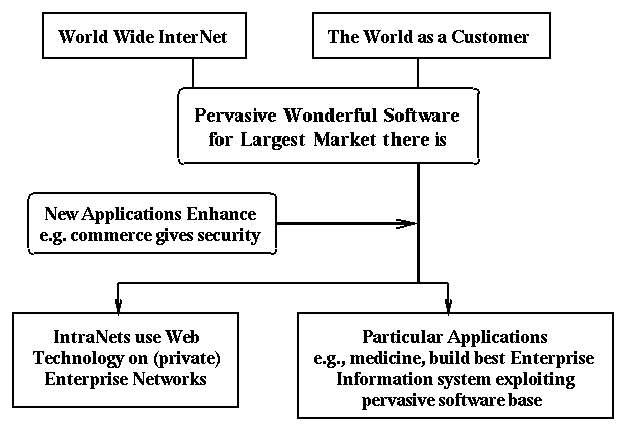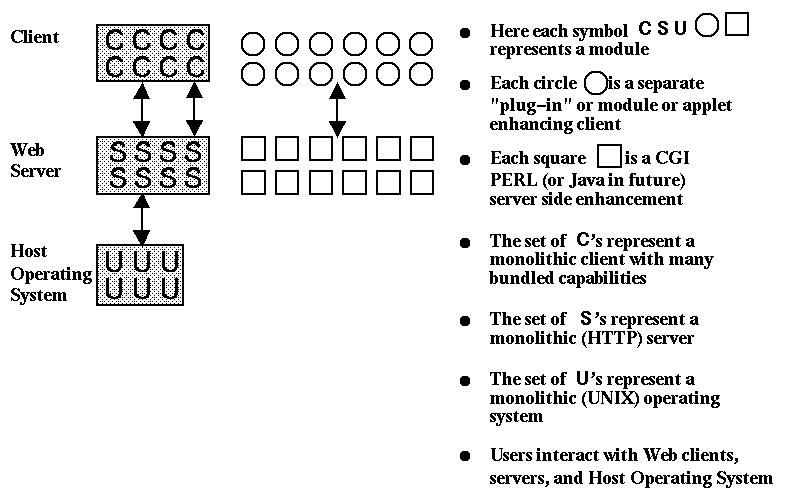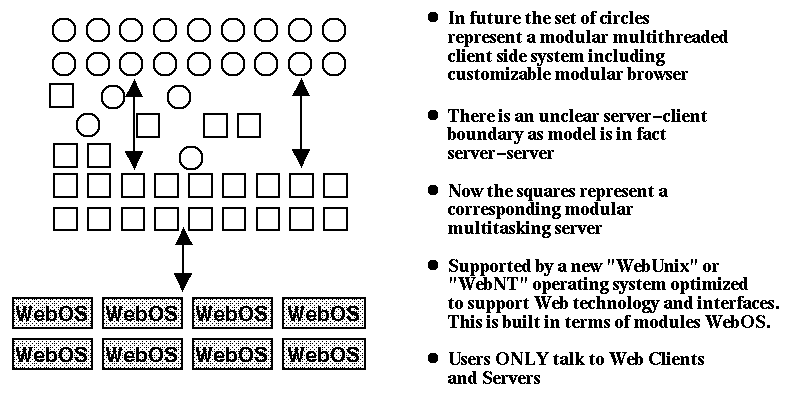

Figures 2 and 3 illustrate the overall architecture of Web software linking multimedia servers and clients with standard interfaces and technologies, such as HTML, VRML, and Java--some key concepts are defined in Table 1.
| Clients (such as Mosaic and Netscape) |
support browsing of hyperlinked documents, but have no internal interactive/compute capability [Andreessen:93a] |
|---|---|
| Servers | read HTTP and deliver requested service to client |
| HTML | document format supporting hyperlinks |
| HTTP | transport protocol defining interaction between
Web servers and clients |
| URL | universal resource locator or addressing scheme for items on the Web |
| MIME | data format allowing agent-like (extended e-mail) communication |
| CGI | standard Web Server interface allowing sophisticated server extensions |
| PERL | rapid prototyping language (Script) aimed at text and file manipulation (systems programming) |
| Java | semi-interpreted C++ like language supporting an applet model of distributed computing |
| JavaScript | interpreted language for manipulating Web components in documents |
| VRML 1.0 | universal description for static three-dimensional objects |
| VRML 2.0 | dynamic 3D descriptor for virtual environments |
| JDBC | set of methods and drivers linking Java to
general relational databases (Java Database Connectivity) |
We believe that the current trend to build applications for this architecture will accelerate. Today, we already see WebMail, WebDatabase (see Figure 8), WebEditor, WebFoil, WebChat, but soon we see a set of more advanced products, such as ``WebWord,'' which will offer the functionality (and more) of Microsoft Word (and similar products) but be built with Web technologies. WebWord is quite different (in architecture and hence implementation) from linking Word to the Web (Weberizing Word as in today's useful intermediate tool, Microsoft's Internet Assistant) and so Microsoft has no special advantage (other than a lot of money and resources) in this emerging WebTop Productivity field. WebWord will use Web standards for all internal and external representations, and so allow easy integration of new functionality, and customization of WebTop environments for particular markets. The Web will not only allow new technologies to develop better versions of current applications (such as word processors) but also produce new uses of computers.


Figure 8: (a) Oracle-Web Integration Architecture; (b) Choices of
Formats and Filters in Web Systems
Remember that when we talk of products using Web technology, it does not have to be applied to the full world-wide Internet. Rather, WebWord could run a single PC which has both server and client capabilities (Figure 4(b)). Again, Web linked relational or object databases (Figure 8 and Section 3.5), and a future WebLotusNotes product could use Web Technology and Webserver systems to support a Business Enterprise Information system or IntraNets on a closed corporate network.
The Web naturally supports virtual organizations with several small entrepreneurial companies linked dynamically together. It will be hard for the large monolithic systems and software companies to be competitive. There will, however, be an interesting systems integration business, which will put together and support linked sets of Web technology modules for particular services in targeted markets and organizations.
The above implicitly defines WebWindows as the target architecture for the future replacing UNIX, Apple Macintosh or the Win32 interface to Windows 95/NT. Bell argues that Windows NT will be the operating system of SNAP; we say that this may be correct but perhaps irrelevant as the real ``action'' will be at the higher level defined by the Web [Fox:96c]. This leverage of the highly functional high volume Web technology to particular applications on particular networks is shown in Figure 9. Note that some applications will require enhancements in the services provided by base Web technology. Security is a good example of a service that is a critical requirement for sectors, such as commerce and defense. In fact, the role and structure of operating systems could change for they need not support users directly, but just Web servers and clients. This changing operating system architecture is shown in the comparison of Figure 10 and Figure 11 where the latter also illustrates the blurring of the distinction between (Web) servers and clients.

Figure 9: This illustrates how economies of scale combined with the
richness of the underlying distributed computing model imply that Web
technologies with well-chosen enhancements can be used for IntraNet
applications.

Figure 10: Architecture of Web Client-Server Software--Netscape
and Internet Explorer Today

Figure 11: Architecture of Web Client-Server Software--The Future as
suggested by Hotjava and Java Servers, such as Jeeves and Jigsaw?
[Bhatia:97a]